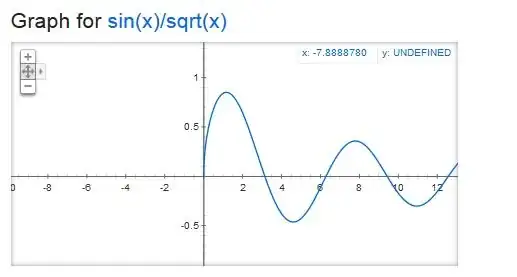It seems to me that your problem is with both, the domain of the function and the definition of limit. So, I will make some comments in this line.
First of all, a function is constituted of three "ingredients":
- a domain;
- a codomain;
- a rule (that, for each element in the domain, assigns a unique element in the codomain).
If we change any of these three ingredients, we obtain a different function which can have different properties (see this for a simple example). So, a function isn't well defined if you only give the algebraic rule (third ingredient above).
However, in the context of real numbers, there is the following convention: to say "the function $f(x)$" without specifying the domain means that the domain is the set of all "acceptable" real numbers $x$ (acceptable in the following sense: for these values of $x$, the value of $f(x)$ is also a real number).
So, in the context of real numbers, the domain of "the function $f(x)=\frac{\sin(x)}{\sqrt{x}}$" is $[0,\infty)$.
Now, the issue of the domain is clear. So, let us we deal with the problem of the limit. In the context of claculus (like in the James Stewart's book) the meaning of
$$\lim_{x\to a}f(x)=L\tag{$*$}$$
is the following: for all $\varepsilon>0$ there exists $\delta >0$ such that
$$0<|x-a|<\delta\qquad\Longrightarrow\qquad |f(x)-L|<\varepsilon.$$
This definition is based in the following hypothesis: the function $f$ is defined on some open interval that contains $a$, except possibly at $a$. Well, in your particular example, the point $0$ doesn't satisfy this hypothesis and thus this definition of limit cannot be applied.
In a more general context, for a real function $f$ with domain $D\subset\mathbb{R}$ and a point $a\in D$ that "can be approximated by elements of $D$", the meaning of $(*)$ is the following: for all $\varepsilon>0$ there exists $\delta >0$ such that
$$x\in D\text{ and }0<|x-a|<\delta\qquad\Longrightarrow\qquad |f(x)-L|<\varepsilon.$$
According to this definition (which is the right definition for your case), to evaluate
$$\lim_{x\to 0}\frac{\sin(x)}{\sqrt{x}}$$
we only have to consider $f(x)$ for $x>0$ (because $x\notin D$ if $x<0$).
Remark 1: the meaning of "$a$ can be approximated by elements of $D$" is the following: for all $r>0$ there exists $x\in D$ such that $x\in (a-r,a+r)$.
Remark 2: the second definition of limit coincides with the first if $a$ satisfies the said hypothesis.
Renark 3: real analysis is what you have to study to make all these things clearer.
 This will clear what i mean..
Limit from the right exist and is zero, but limit form the left does not exist,,
Hence the limit of the function as it tends to 0 does not exist?? or does it? i am just asking that......
This will clear what i mean..
Limit from the right exist and is zero, but limit form the left does not exist,,
Hence the limit of the function as it tends to 0 does not exist?? or does it? i am just asking that......